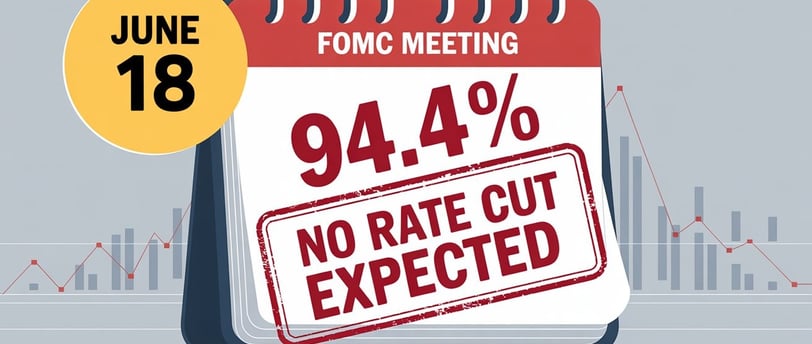Fed on Pause? June Expectations, Trump's Tariff Impact, and the Historical Pattern of Monetary Policy
The global financial market eagerly awaits the Federal Reserve's (Fed) next interest rate decision, scheduled for June 18th. However, the vast majority of analysts and the market itself already seem to have a consensus: the probability of a cut is minimal. But what lies behind this Fed cautiousness? How do the Trump administration's policies, especially tariffs, influence this scenario? And what do historical patterns tell us about the American monetary authority's next steps?
5/28/20254 min read


Fed on Pause? June Expectations, Trump's Tariff Impact, and the Historical Pattern of Monetary Policy
The global financial market eagerly awaits the Federal Reserve's (Fed) next interest rate decision, scheduled for June 18th. However, the vast majority of analysts and the market itself already seem to have a consensus: the probability of a cut is minimal. But what lies behind this Fed cautiousness? How do the Trump administration's policies, especially tariffs, influence this scenario? And what do historical patterns tell us about the American monetary authority's next steps?
In this analysis, we'll unravel the expectations for the June meeting, the "wait and see" strategy adopted by Jerome Powell and his team, and how crucial economic data, like the PCE, might shape the future of US interest rate policy.
June Fed Meeting: Market Almost Certain of Rates on Hold
The bets for the Federal Open Market Committee (FOMC) meeting on June 18th are clear.
Analysts' Bet (CME): 94.4% Chance of Unchanged Rates
According to CME analysts, the chance of no cut in US interest rates (Fed Funds Rate) is an overwhelming 94.4%. This indicates a strong conviction that the current monetary policy will be maintained, with only a 5.6% probability assigned to a 25 basis point cut (from 4.25-4.50% to 4.00-4.25%).
The Cautious Outlook: Possible Cut Only in September?
The forecast is that the Fed will keep rates in the current range of 4.25% to 4.50% through the first quarter of 2025, with a possible first cut occurring only in September. This stance reflects the central bank's caution after the cumulative 100 basis point cuts made at the end of 2024. Since then, the FOMC has adopted a "wait and see" approach.
The Impact of Trump's Policies and the Fed's Strategy
Current monetary policy cannot be dissociated from the Trump administration's actions, especially regarding trade tariffs.
Tariffs and Inflation: Jerome Powell's Dilemma
The Fed is carefully assessing the economic impacts of new fiscal policies and, crucially, the imposed tariffs, which have altered import cost dynamics and domestic competitiveness. These factors add a layer of complexity to the fight against inflation.
Waller's Condition: Rate Cuts vs. Tariff Levels
Fed Governor Christopher Waller has signaled that rate cuts are still possible this year but conditioned this possibility on Trump's tariffs remaining close to 10%. Higher tariffs could reignite inflationary pressures, limiting the Fed's room to loosen monetary policy.
Slowdown Ahead? US Growth Projected at Only 1.3% for 2025
With interest rate cuts suspended, US economic growth is expected to slow to 1.3% in 2025, a considerable drop from the 2.8% recorded in 2024. Excluding the 2020 pandemic year, this would be the worst annual performance since the 2009 global financial crisis, reflecting challenges such as rising input costs, deteriorating external demand, and the prolonged effects of monetary restrictions.
The Fed's "Wait and See": Is a Historical Pattern Repeating?
The Fed's current cautious strategy is not new but follows a recurring pattern.
Previous Cycles (2008, 2020): Strategic Pauses After Initial Cuts
Analyzing the monetary policy cycles of 2008 and 2020, a similar approach is observed:
2008: After initial cuts, rates remained stable from May to August (4 months).
2020: There was stability from November to February (also 4 months) after the first cuts.
The Current Cycle: 4 Months Since the Last Cut, Following the Script?
Interestingly, in the current cycle, the last interest rate cut occurred exactly 4 months ago, reinforcing the consistency of this historical pattern of pauses for assessment.
The Logic Behind the Pause: Impact Assessment and Data-Driven Decisions
This strategy allows the Fed to monitor the cumulative effects of interest rate changes on the economy, ensuring future decisions are based on concrete data and minimizing the risks of excessive or insufficient adjustments.
Crucial Data on the Horizon: What Can May's PCE Report Reveal?
The market's attention turns to upcoming economic indicators, which will provide vital information for the Fed.
PCE, Unemployment, and GDP: The Economy's Thermometer (May 29th)
On May 29th, important data will be released:
The Personal Consumption Expenditures (PCE) Price Index, considered the Fed's favorite inflation indicator.
Unemployment data.
A revised Q1 GDP.
The EU Tariff Threat and Market Reaction (Bond Yields)
This PCE report is particularly relevant amidst growing volatility, fueled by the Trump administration's threat to impose 50% tariffs on the European Union. This threat has already pushed 10-year bond yields above 4.55%, reflecting concerns about inflationary impact and financing costs.
Monetary Policy Challenges in a Complex Scenario
Despite market pressure, the Fed maintains its cautious stance, with investors projecting a possible rate reduction only from September or December.
Balancing Inflation, Stability, and Growth
Monetary policy faces the challenge of balancing inflation control, maintaining financial stability, and managing risks associated with global trade tensions, all while seeking to sustain economic activity in a slowing environment.
Conclusion: Navigating Fed Caution and Economic Uncertainty
Expectations for the Fed's June meeting point towards maintaining interest rates, reflecting a "wait and see" strategy that finds parallels in previous cycles. The impact of the Trump administration's tariff policies and the evolution of economic data, especially the May 29th PCE report, will be crucial in defining the monetary authority's next steps.
Navigating this scenario requires attention to data, understanding the Fed's historical patterns, and a careful analysis of the complex interactions between monetary policy, fiscal policy, and global trade tensions.
To stay updated on Fed decisions and their implications for the markets, including cryptocurrencies, keep following our analyses!
